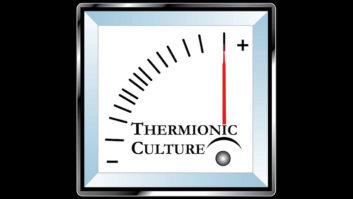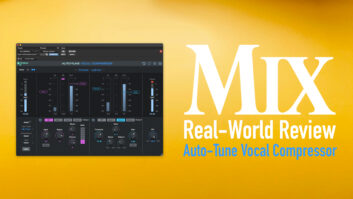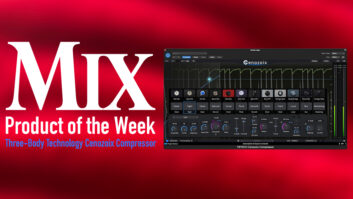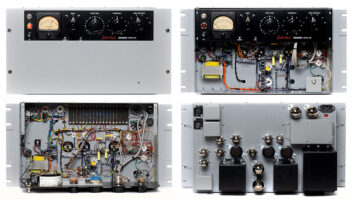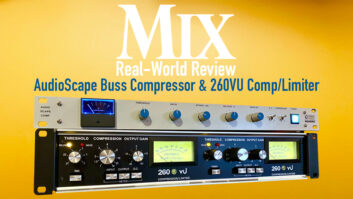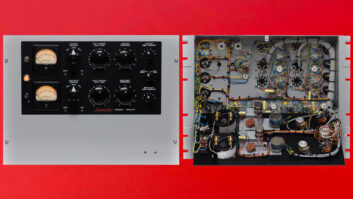
Thermionic Culture’s The Phoenix is a pretty rare bird. It’s avariable-mu tube compressor — the first type of compressor evermade. Few manufacturers offer variable-mu compressors these days,Manley Labs and Pendulum Audio being notable exceptions. Yet those inthe know seek out these unique processors for their idiosyncraticsound.
Variable-mu compressors use a tube as the gain control element. Theyare inherently soft-knee compressors: the harder you drive the gaincontrol tube by cranking the input level, the higher the compressionratio becomes, which causes an increasing densification of theprocessed sound as the gain control tube approaches saturation. Becausetubes generally have a more limited dynamic range than other gaincontrol elements, they usually can’t produce more than 15 dB of gainreduction. Generally faster in action than opto-electronic compressorsbut not as fast as those that use VCAs or FETs, variable-mu compressorsproduce a unique dynamic response.
This 2-channel, 3U-high unit can be operated in either dual-mono orlinked in stereo. Each channel has a continuously variable channel(input) gain, attack time, release time, threshold, output trimcontrols, a toggling bypass switch and large VU meter. A link controlis provided for stereo operation.
There are no ratio controls — boosting a channel gain controlsimultaneously adjusts input gain and drive level for the PCC85 tube,which serves as the gain control element. The Phoenix’s initialcompression ratio is 1.2:1, increasing to 5:1 with 15 dB ofcompression. Attack times range between 4 and 120 ms, and release timesvary from 60 ms to 2.2 seconds. Factor in its wide-ranging thresholdcontrol, which actually precludes compression when in the fullyclockwise position, and you’ve got a unit that offers both subtle anddramatic processing.
The rear panel has balanced XLR I/Os. Huge air vents on the chassis’top, rear and sides keep it cool. Knob positions and meter readings areeasily seen from a distance. The Phoenix has a bit of a homegrown lookthat should appeal to boutique-audio enthusiasts. All controls have asolid feel, and internal componentry looks tidy.
Hash marks on the rotary controls are denominated using arbitrarynumbers that range from 1 to 11; decibels and units of time would bemore informative. The front panel does not display if the link and twobypass switches are activated when in the up or down position. I foundmyself adjusting a channel gain or output trim knob to tell (bylistening) whether a channel was bypassed.
The effect of all rotary controls is removed from the audio pathwhen a channel’s bypass switch is engaged, yet the channel’s VU meterstill registers the amount of gain reduction that would be affected ifthe channel was activated. This allows you to dial in reasonablesettings in front of clients before switching in the processing.Unfortunately, the VU meters are not backlit, and the Phoenix does notoffer any sidechain inputs.
Specs are good: Inherent noise floor is 95 dB below the maximumoperating level, and frequency response varies less than 1 dB between12 and 56k Hz. Maximum gain is 30 dB, making it compatible with +4dBuand -10dBV nominal levels.
SOARING ON ITS FIRST FLIGHT
I recorded various sources using a Millennia HV-3D mic preamp. ThePhoenix consistently smoothed each track’s fluctuating dynamics in anunobtrusive manner. Compressing male lead vocals (recorded with an AKGTLII mic) 4 to 5 dB, I did not hear pumping. The track sounded muchfatter and less clinical. The Phoenix also seemed to broaden thelow-mid frequencies, which was not always a plus.
With an Aguilar DB 900 DI on the front end, 2 to 4 dB of gainreduction smoothed an electric bass track’s dynamics nicely over theinstrument’s range. For this track, I set The Phoenix’s attack controlto “7” (fairly high) to avoid losing presence. With carefultweaking, the compressed track sounded great.
I made a kick drum track pop pretty hard by applying 2 dB of gainreduction. (I’m sure the actual amount was far greater, but it didn’tfully register due to the VU meter’s inherently slow response.) Settingattack and release times to their fastest settings did not produce anyaudible distortion on the processed track.
I got great results applying 2 to 3 dB of gain reduction to anarpeggiated, stereo acoustic guitar track. The Phoenix delivered thepleasing density for which variable-mu compressors are sought. The Linkcontrol kept the stereo image rock-solid. However, the channel gain andoutput trims are not linkable. The best results for stereo operationsare achieved when using matched settings for these controls.
The Phoenix really impressed me when used as a stereo buscompressor. Compressing a rock ballad 3 to 4 dB on peaks, the resultwas intoxicatingly creamy and bold, with beautiful density and sustain.The Phoenix rounded the mix’s edges to produce a softer sound withmoderated detail. Bass and low-midrange frequencies were broadened,adding thickness and size to digital tracks. I could easily crank themix up to aggressive levels without causing audible pumping. Like otheranalog compressors, when using this much compression, my only complaintwas a slight loss of depth. But on balance, the overall sound wasextremely flattering.
The Phoenix rises to meet most challenges gracefully. Althought itis expensive ($4,295), if you want that characteristically dense andcreamy variable-mu sound, The Phoenix is worth a serious listen to.
Thermionic Culture (dist. by Unity Audio), 44/1440/785/843, www.unityaudio.co.uk.
Michael Cooper is the owner of Michael Cooper Recording, locatedin Sisters, Ore.
